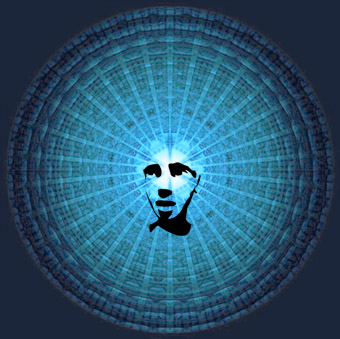Anthropocentrism is a limiting inner attitude
Many texts promoting spiritual growth are anthropocentric in design. This means that reality is determined from a limited human perspective. Stopping anthropocentric thinking is a difficult and actually almost impossible task. But if we don’t somehow rein in our anthropocentric attitude, a significant limiting inner mindset will remain that hinders our inner liberation.
Everything (here and elsewhere) about Consciousness and about Advaita is written, comes from the human mind. This also applies when we talk about unconditional love, for example. In fact, everything we experience is an appearance in the subtle/spiritual world (not in the physical/material world, nor in the causal/causal world). Everything appears as an experience in our minds. The total subtle world – of which our human mind is a part – is called the Holy Spirit. The subtle world of the Spirit ranks between the causal world and the world we perceive as physical, although the boundaries between these different worlds of subtlety are not rigid, as they all arise from and are permeated by Consciousness: they blend into each other, as is increasingly recognized in science.
It is clear that all non-material matters and experiences take place in the subtle world. We function and respond with our human psyche, part of our human spirit, on the one hand from causal factors: from our nature, our essence, our determinacy. On the other hand, we respond to manifest influences from outside, such as physical and subtle circumstances.
In short: the entire range, from simple human feelings of (dis)pleasure to the full intelligent understanding of the advaita paradigm and unconditional love, is something of our human spirit, and is therefore limited to human measure. Moreover, all spiritual functioning is under the coloring influence of the human psyche, which cannot be turned off in our perception of everything. By psyche, I mean all mental qualities a person can have, both healthy and pathological. Our psyche influences how and what we perceive, and to some extent makes our perception impure.
Creation
 In popular literature, it’s sometimes assumed that from our minds, through thoughts and feelings, we create tangible creations. This is an anthropocentric view of our vast universe. I can certainly see that our thoughts can create a lot. They exert influence, and since everything is fundamentally interconnected, they have a certain effect. For example, if I think negatively about someone, it’s quite possible I’ll provoke a major argument. And if, as a physicist, I contemplate space and time, a formula like E = mc2 might emerge. Even an atomic bomb begins as a design, a mental ‘creation’, with all the consequences that follow. However, considering there are about 200 billion galaxies in our known universe, we as humans can’t just ‘think up’ a few billion more or ‘create’ other universes than ours. The subtle scope of our human mind is simply too small for large-scale effects. The scale of our universe is already incalculable, and that of the Absolute is entirely immeasurable. Yet, on our small worldly scale, we can, through intentions, certainly influence how things proceed, as the intention experiments of Lynne McTaggart have shown. We can also influence our physical state with affirmations and intentions, thereby healing disease symptoms in this way.
In popular literature, it’s sometimes assumed that from our minds, through thoughts and feelings, we create tangible creations. This is an anthropocentric view of our vast universe. I can certainly see that our thoughts can create a lot. They exert influence, and since everything is fundamentally interconnected, they have a certain effect. For example, if I think negatively about someone, it’s quite possible I’ll provoke a major argument. And if, as a physicist, I contemplate space and time, a formula like E = mc2 might emerge. Even an atomic bomb begins as a design, a mental ‘creation’, with all the consequences that follow. However, considering there are about 200 billion galaxies in our known universe, we as humans can’t just ‘think up’ a few billion more or ‘create’ other universes than ours. The subtle scope of our human mind is simply too small for large-scale effects. The scale of our universe is already incalculable, and that of the Absolute is entirely immeasurable. Yet, on our small worldly scale, we can, through intentions, certainly influence how things proceed, as the intention experiments of Lynne McTaggart have shown. We can also influence our physical state with affirmations and intentions, thereby healing disease symptoms in this way.
All manifest forms and creations in the universe (and other universes) arise from the causal world (specifically, through the Akasha medium field) and come to physical manifestation via the subtle world. But not through the minute partition in the subtle world that we call ‘our human mind’. That is anthropocentric thinking (and thus essentially arrogant). Anyone who makes a habit of studying the latest scientific findings and frequently observes our night sky will soon know better. The ‘housekeeping’ in an atom or in a black hole, for example, also entirely takes shape by (and within) the subtle world of the Spirit, from fixed causal (causative) circumstances.
In short: we need to realize that we must truly learn to see in a broader perspective. Our perception, however impossible it seems, must be non-anthropocentric. We have to accept that human consciousness and its influence, due to its determinacy, are very limited.
For consideration:
Andromeda (M31) is one of the nearest galaxies among the over 200 billion galaxies in our universe and has a spiral shape like our Milky Way, but is considerably larger. The Andromeda Galaxy is approximately 2.5 million light-years away from Earth. The light from it that we can now see on a clear night with the naked eye was thus ’emitted’ about 2.5 million years ago. That’s even before the emergence of homo-erectus. Humans, as we know them, homo-sapiens, emerged about three hundred to two hundred thousand years ago. The combined light from 1000 billion Andromeda stars had been traveling to our earth for over two million years by the time homo-sapiens emerged, traveling at 300,000 km per second! Contemplate this for a moment.
Zoom here using your scroll-wheel to view a section of Andromeda (less than a quarter), revealing immense detail. All the major stars visible in this mega-fragment are located between us and Andromeda and are thus stars from our own Milky Way galaxy.
All-encompassing Consciousness
The proposition that Consciousness is the all-encompassing Source has become quite established in the human, spirituality-practicing mind. Whether this paradigm is True, we cannot know, and yet Zelfkennis.nu also assumes it. Precisely because Consciousness would be all-encompassing, it encompasses the entire human being. We experience our consciousness reflectively, allowing self-perception and self-reflection. As a result, humans are capable of experiencing this all-encompassing Consciousness within themselves (and around them), thanks to that human self-reflective mind. A horse, also a manifestation in Consciousness, cannot do this, neither can a flower, nor a sun. This makes humans (as far as we can assess now) an exceptional form of life. However, this exceptionality should not lead to the assumption that everything in the realm of spirituality can be reasoned and explained from this human mind. The majority of all phenomena cannot be explained or proven by us. And YET, much can be ‘known’ at an intuitive level. This is possible because, as humans, we are a reflection of that all-encompassing Consciousness. Our mental organs are capable of picking up a lot from the information ‘archive’ of the causal Akasha field, the nature of the all-encompassing Consciousness, provided we have purified our minds from various inner clutter.
Practice and Theory
In our human experience – thanks to our human nature that allows us reflective perception – lies precisely our opportunity to truly behold the all-encompassing Consciousness and the Advaita paradigm. If we can come to a complete mental and emotional standstill, we will be able to experience a vast unity consciousness. Thus, it’s about experience. Beyond that experience, there is only ‘intellectual property’ and ‘theoretical philosophy’; theorizing as a plaything for our mind and psyche may be very interesting and fun, but that’s about it. It’s inner playfulness, which we can freely practice thanks to our excellent creative mind, but which also often bestows upon us that anthropocentric mindset. This happens due to identification at a ‘high’ level: identifying with the spiritually conscious human being can yield a so-called ‘enlightened-mind-ego’ (I am God-like), which is anthropocentric and therefore undesirable. And then we are actually further astray than a horse, a flower, and a sun, which do not have this limiting self-view.
In summary: the human mind in its entirety represents just a limited ‘partition’ of the Universal Mind. The Universal Mind is what the subtle world of Consciousness is called. Nothing that happens in us (reflectively), in terms of perception and experience, can fall outside this ‘partition’, no matter how intense, overarching, and revealingly spiritual it may be. Each of our experiences falls within the subtle world of our human mind, including, for instance, a God-experience of total bliss. It cannot possibly fall outside of it. Every experience exists thanks to our human mind with all its possibilities, but also within its limitations. The more our inner shadows, which obstruct pure perception, dissolve, the more grand and subtle our experiences become. Thus, our human mind can become ‘more expansive’ in terms of experience (expanding spirit / consciousness expansion) and move towards a fuller experience of the Universal Mind (experiencing the entire subtle world). But yes… still within the bounds of our human possibilities which are determined from the causal world as our individualized human essence: our human nature.
 Those who can no longer marvel intensely
Those who can no longer marvel intensely
at the immeasurably vast and the minuscule in our universe
have imprisoned themselves
in the cell of narrow-minded human-being:
the cell of anthropocentrism ~ M.K.
.
.
Reading tip:
“Cosmic Vision – Science and the Akasha Field” – Ervin László
AnkhHermes, ISBN 9789020283594, 2004
In this book, Ervin László sets forth a very sound paradigm. Clearly articulated. Aligned with the latest scientific discoveries on the one hand, and ancient high-status philosophies on the other (Advaita Vedanta).
The importance of this description lies in the clarity with which the ‘transition area’ between unmanifested Potential (the Absolute – the Source) and the manifested (the Universe) is illuminated: a causal field in which everything is ‘stored’ outside time and space, though one can’t really name it as such because there exists no word for it. László describes it as a kind of non-dimensional holographic imprint.
This book is an introduction to understanding how all that is manifested (at various densities) arises from informed-ness from this A-Field (Akasha) and thereby can exist and retain form, but also how the manifested reciprocally informs this causal Field, enabling evolution. And all of this on both micro and macro levels.
Ervin László (1932) is a Hungarian philosopher of science (and formerly a concert pianist). He has a doctorate from the Sorbonne and holds four honorary doctorates. He was previously a professor of philosophy, systems science, and futurology at various universities in the US, Europe, and Asia. He engages with (among other things) system theory and the integral approach that is increasingly sought after (unification theory). Moreover, he is the founder of the Club of Budapest and editor of World Futures: The Journal of General Evolution. László has been nominated twice for the Nobel Peace Prize.

